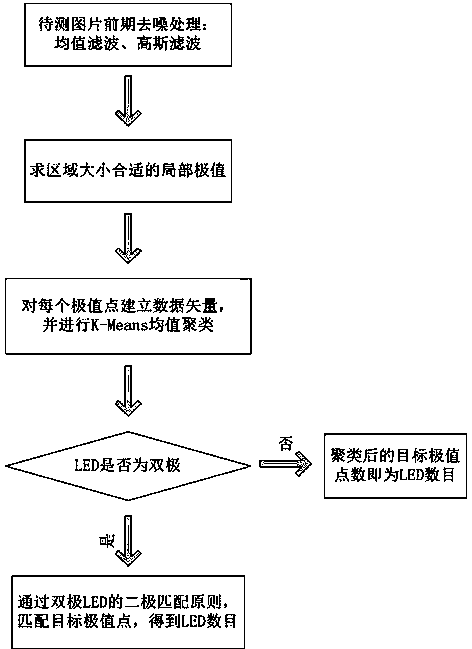A method for counting light-emitting diodes using local extremum clustering
A light-emitting diode and local extremum technology, applied in the field of counting light-emitting diodes, can solve problems such as unsatisfactory image processing, difficult identification and counting, and long processing time
- Summary
- Abstract
- Description
- Claims
- Application Information
AI Technical Summary
Problems solved by technology
Method used
Image
Examples
Embodiment Construction
[0042] Concrete algorithm of the present invention is as follows:
[0043] Local extrema clustering algorithm (LMC)
[0044] enter: LED image img.
[0045] 1. Read the data in img and save it in the two-dimensional array I: QImage image(img); I[i][j] = (int)qGray(image.pixel(j,i));
[0046] 2. Mean filter and Gauss filter denoising: J = midfilt(I,3); K = gaussfilt(1.6,9,J); where, midfilt and gaussfilt represent mean filter and Gauss filter function respectively;
[0047] 3. Calculation of local minimum points: For image data to save a two-dimensional array K, the calculation method of local minimum points is as follows:
[0048] For the data K(i,j) in each image,
[0049] If K(i,j) has not been visited, then
[0050] Compare K(i,j) with the size of the gray value of each pixel in an area whose center size is N*N (N is a fixed value), if K(i,j) is the minimum value, then Make sure K(i,j) is a local minimum point.
[0051] Until the processing of all data K(i,j) ends...
PUM
 Login to View More
Login to View More Abstract
Description
Claims
Application Information
 Login to View More
Login to View More - R&D
- Intellectual Property
- Life Sciences
- Materials
- Tech Scout
- Unparalleled Data Quality
- Higher Quality Content
- 60% Fewer Hallucinations
Browse by: Latest US Patents, China's latest patents, Technical Efficacy Thesaurus, Application Domain, Technology Topic, Popular Technical Reports.
© 2025 PatSnap. All rights reserved.Legal|Privacy policy|Modern Slavery Act Transparency Statement|Sitemap|About US| Contact US: help@patsnap.com



